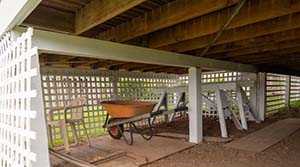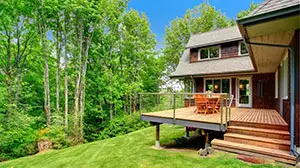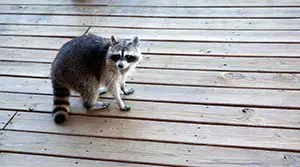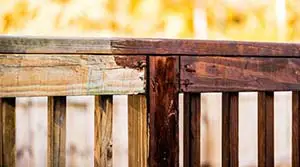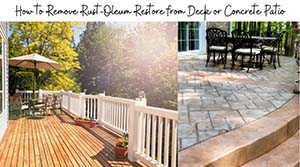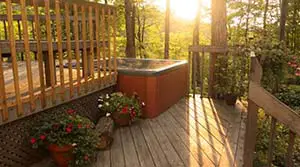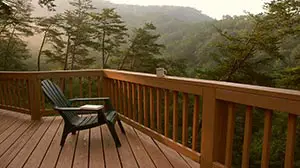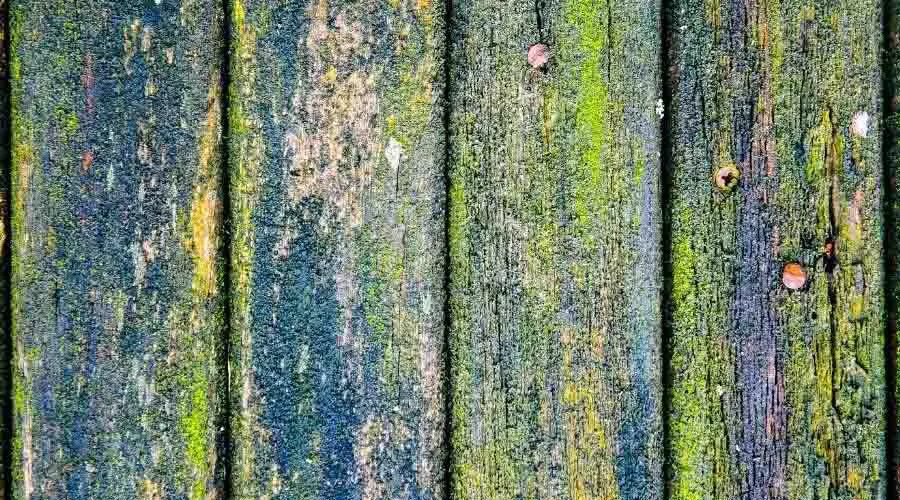
We have all seen video clips of folks running out of the house and falling because of a slippery deck. Usually, the first thing going through our minds is, ‘glad that was not me.’ Well, there are some easy steps to make sure that it will not be you or a family member next time.
There are 13 ways to prevent a slippery deck;
- Sweep away all leaves & debris
- Bring in more sunshine
- Remove all snow & ice
- Ensure proper drainage
- Use soap & cleaning solutions
- Use a pressure washer
- Use an algae & mold remover solution
- Apply anti-slip tape
- Install anti-slip strips
- Use a non-slip coating
- Add texture to your paint/sealant
- Add anti-slip inserts
- Apply water-repellent preservative
You can ensure that your deck or patio will be a safe and enjoyable place for your family and friends by purchasing the correct materials and performing regular maintenance.
Here we will help you to clean and protect your deck with many helpful tips and tricks along the way to save you time, money, and headaches.
Why is My Deck Slippery?
Before getting to the solution, we need to identify and understand the problem.
The reasons why a deck surface may be slippery vary but often include:
- Mold, mildew, algae, or moss growth
- Smooth and wet surfaces
- Snow or ice buildup
As you can see from the list above, these are all products of too much moisture. As such, many of our solutions will center around removing water.
Have a look at your patio or deck space and think about the sources of moisture. Look at which areas tend to get wet and stay wet, and what could be on the deck that holds in water or prevents drying.
Once you figure out why your deck is slippery, you can most conveniently and cost-effectively address the issue.
How Do You Prevent a Slippery Deck?
The best way to avoid slips and falls is by not allowing your deck to get slippery in the first place. So, let’s go over some of the things you can do to prevent moisture from building up on your deck.
1. Sweep Away All Leaves & Debris
Leaves, grass, dirt, and other debris trap moisture and block the sun. Because of that, these areas stay wet for days after it rains.
Add in the fact that most of these items contain nutrients valuable for microbial growth, and you get the perfect conditions for algae and mold to take hold.
Algae and mold growth is the leading cause of slippery decks, so make sure it doesn’t stand a chance. Sweep away all debris regularly and keep the deck surfaces clean.
Also, look for other sources of nutrients, such as a dirty gutter that drains down onto your deck. If you don’t have the time or are away from your home often, consider trimming back bushes and trees to prevent leaf litter from falling on the deck.
2. Bring in More Sunshine
Another thing you can do to prevent mold and other micro-fauna from taking up residence on your patio is to keep it sunny. Shady areas are lovely to sit in but allow moisture to persist longer.
You can purchase retractable awnings or umbrellas and clear glass tables. It is also good to remove all patio cushions during the winter or rainy seasons. These tend to stay wet and drip for hours or days after heavy rain.
You may also consider trimming or removing tree branches that block significant amounts of light. Doing so will improve the amount of sunshine hitting the deck to dry it and prevent slimy surfaces.
3. Remove All Snow & Ice
Snow and ice are obvious reasons for a slippery deck. But less obvious is the moisture they add to a wood or concrete deck. Of course, we always want to remove snow and ice to prevent slips.
A common way is to use salt and other de-icers like magnesium chloride, calcium chloride, or other chlorides. While this will remove the ice issue, it can cause other problems down the road.
There are many reasons why you should avoid rock salt. But specifically, we are concerned that it will erode and cause discoloration of the wood and harm surrounding gardens.
Many people are aware that chlorides are safer for pets and surfaces. And this is true for the wood and finish of your deck. However, be mindful that these products will corrode your deck’s metal screws and nails.
The least corrosive option is Calcium Magnesium Acetate or CMA, which can effectively melt ice without causing much corrosion and is the preferred product for wood decks.
CMA is not perfect, however, and will penetrate the pores of the wood and hold moisture. It is best to clean your deck every spring to remove all traces of CMA from the winter months.
4. Ensure Proper Drainage
The last way to prevent sitting water or prolonged exposure to moisture is to ensure your deck is draining effectively. Here are the steps you can do to ensure proper drainage:
- Check the spaces between the deck planks to ensure they are adequate.
- Ensure there is no standing water under low-lying decks. There should be at least a ⅛ in. gap between deck boards to allow water to drain and air to circulate.
- Make sure that the gaps are wide enough and not clogged up with leaf litter or debris by cleaning with a paint scraper or putty knife.
- Check under low-lying decks to ensure there is no standing water present.
- You may need to dig a drainage ditch or add sand and gravel.
- If you have an air conditioner on or over your deck, use PVC to redirect the condensation water away from the decking.
What is the Best Way to Clean Slippery Decking?
Prevention is, of course, the best path, but what if your deck is already slippery? There are several ways to solve these issues, usually without spending much money.
5. Use Soap & Cleaning Solutions
If the mold, mildew, or algae is not too entrenched, then you can usually get rid of it with a bit of soap and elbow grease. We recommend a cleaning solution using Oxiclean and dish soap in a bucket of warm water.
If you do not have Oxiclean, you can use other oxygen-based bleaches, but do not use chlorine-based bleach because it will stain the wood on your deck. Chlorine bleach can also be dangerous to eyes, skin, pets, and gardens.
Apply the solution and scrub with a soft to medium-hard bristled brush (be careful not to scratch your wood or finish). Allow 20-30 minutes before washing off with a garden hose.
6. Use a Pressure Washer
A pressure washer is a great way to clean your deck without the use of chemicals or soap. Be sure to use the fan setting on the nozzle and keep it far enough not to cause any damage to the wood.
Use the pressure washer to lift away any algae, mold, or dirt and to get in between the deck planks. We recommend pressure washing your deck every year in the spring and fall to prevent the accumulation of dirt and grim.
7. Use an Algae & Mold Remover Solution
If elbow grease is not your thing, then head to your nearest home improvement store and pick up some spray-on Mold and Mildew Remover.
These products can be sprayed on, left to sit, and then sprayed off with a garden hose. Be sure to find a biodegradable and pet-safe brand to prevent any issues for pets or damage to your gardens.
What Can You Put On the Decking to Make it Non-slip?
Now we have covered how to prevent this issue and rectify it when it occurs. If you have taken all the precautions to avoid the problem and cleaned your deck, then let’s go over additional steps you can take to make it fall-free.
We will present several alternatives to decide which works for you based on price, ease of installation, and appearance. We have also made a handy chart to help you make your decision.
| Product Description | Relative Cost | Ease of Installation | Longevity |
|---|---|---|---|
| Anti-slip tape | Lowest | Easiest | Short-term/replace often |
| Anti-slip strips | High | Easy to Intermediate | Long-lasting/robust |
| Non-slip coating | Medium | Easy | A few years |
| Added textured to paint/ sealant | Low (If already planning to reseal) | Easy (if already sealing deck) | A few years |
| Anti-slip inserts | High | Easy | 20+ Years |
| Water repellent wood preservative | Low | Easy | 1 Year |
Below, we will give you more details to help you decide and get the best results.
8. Apply Anti-Slip Tape
Anti-slip tape is the cheapest and the most straightforward option listed above. Rolls of anti-slip tape cost between $10-30 dollars for a twenty-foot roll.
The tape is self-adhesive, and to install, clean the area well and then stick it on. But, as expected, that means it is the least robust.
Tape is helpful for jobs that need doing quickly, or if weather and time of year prevent more permanent solutions.
Often cleaning the surface with rubbing alcohol for the last step will ensure better adhesion. Many users report that the grip tapes look unsightly and do not last long before becoming unstuck.
9. Install Anti-Slip Strips
Anti-slip strips have a similar grip as the tape but are much more robust. They are made out of solid plastic, fiberglass, or metal and are glued or screwed to the surface.
While they are a higher initial investment, they require little to no maintenance and could last the deck’s lifetime. These tend to be much more attractive than the tape and come in various designs and colors.
If you browse the available options and plan your build to include them, they will look like a natural feature of your deck.
They are also a great option if your deck or patio has stairs. They will often last as long or longer than the wood on your deck.
10. Use a Non-Slip Coating
Non-slip coatings are a great way to provide traction if your deck is already stained or painted. They are a clear coat that goes on top of your other sealants and provides instant traction.
They are super easy to apply, using a brush or roller as you paint or stain. You can apply a non-slip coating to untreated wood, concrete, and metal.
The cost is about $130 to cover up to 350 square feet and will need reapplication every few years or when refinishing your deck.
Similar to the coatings, there is also a non-slip decking oil. These are useful if you have a new deck and are thinking about using an oil finish.
11. Add Texture to Your Paint/Sealant
Use paint or stain with added texture if you refinish your deck and know that it tends to get slippery. There are decking sealants that contain surfaces and aggregates already, or you can add them to your preferred brand.
Commercially available anti-slip paints for patios and decks cost about $40-80 dollars a gallon and cover approximately 125 square feet.
If you already have paint or stain, you can either mix fine sand (usually available in the concrete aisle) into it or purchase anti-slip additives such as SharkGrip for relatively cheap. To use, mix directly into your paint or stain and apply as standard with a brush or roller.
12. Add Anti-Slip Inserts
Anti-slip inserts are aluminum and fit in gaps between deck planks or specially designed groves. They are more attractive and long-lasting options available but have a higher initial cost.
They are an attractive option for commercial applications and at home and will last for decades.
13. Apply Water-Repellent Preservative
Water-repellent preservatives contain wax or oil that penetrates the pores of the wood. They repel moisture and keep the wood from molding, and are less likely to grow algae.
This will not add texture or grip to the surface, unlike the other options. So, it is not anti-slip, but it will prevent many of the problems leading to slippery decks that we discussed earlier.
These are best applied to untreated wood but can also be used over other stains and finishes (however, with less effectiveness).
They are easy to apply just by spreading on with a roller or brush and allowed to dry. You will need to reapply every year.
Conclusion
No matter the cause of your slippery deck, you should now have all the info you need to remedy the situation.
Remember to keep it clean and dry, and if necessary, use some of the products we mentioned to provide traction. By following these steps, you can ensure that your deck is both beautiful and safe for your family and friends to enjoy.
Sources

